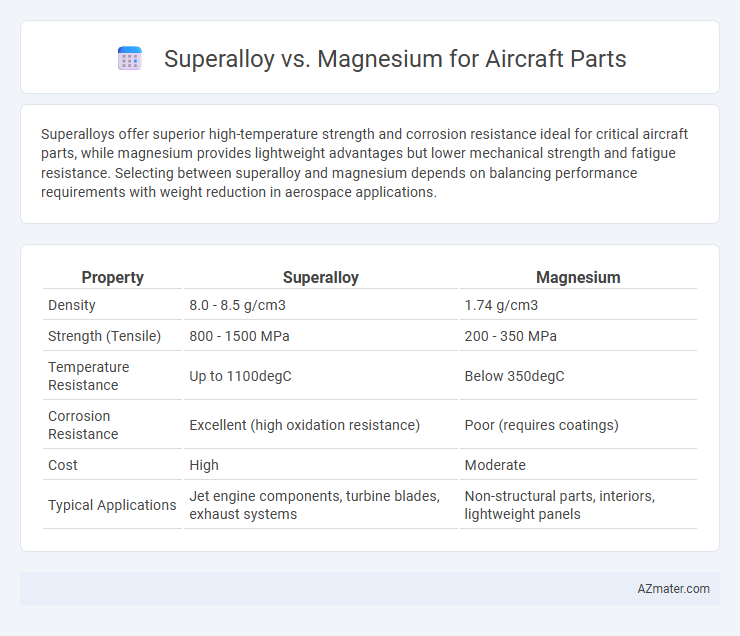Superalloys offer superior high-temperature strength and corrosion resistance ideal for critical aircraft parts, while magnesium provides lightweight advantages but lower mechanical strength and fatigue resistance. Selecting between superalloy and magnesium depends on balancing performance requirements with weight reduction in aerospace applications.
Table of Comparison
| Property | Superalloy | Magnesium |
|---|---|---|
| Density | 8.0 - 8.5 g/cm3 | 1.74 g/cm3 |
| Strength (Tensile) | 800 - 1500 MPa | 200 - 350 MPa |
| Temperature Resistance | Up to 1100degC | Below 350degC |
| Corrosion Resistance | Excellent (high oxidation resistance) | Poor (requires coatings) |
| Cost | High | Moderate |
| Typical Applications | Jet engine components, turbine blades, exhaust systems | Non-structural parts, interiors, lightweight panels |
Introduction to Superalloys and Magnesium in Aerospace
Superalloys, primarily composed of nickel, cobalt, or iron, exhibit exceptional high-temperature strength and corrosion resistance, making them ideal for critical aircraft engine components such as turbine blades and combustors. Magnesium alloys offer lightweight properties with excellent machinability and moderate strength, commonly used in non-structural aerospace parts like interior panels and gear housings to reduce overall aircraft weight. The combination of superalloys' thermal performance and magnesium's weight savings plays a crucial role in optimizing aerospace design for efficiency and durability.
Material Properties Comparison: Superalloy vs Magnesium
Superalloys exhibit exceptional high-temperature strength, corrosion resistance, and creep resistance, making them ideal for critical aircraft components exposed to extreme environments. Magnesium alloys offer excellent strength-to-weight ratio and low density, contributing to significant weight reduction but with lower corrosion resistance and thermal stability compared to superalloys. The choice between superalloy and magnesium depends on balancing temperature tolerance, mechanical strength, and weight considerations in aircraft part design.
Strength and Durability in Aircraft Applications
Superalloys, primarily composed of nickel, cobalt, or iron, offer exceptional strength and high-temperature durability critical for turbine engines and structural components in aircraft, outperforming magnesium alloys in thermal stability and fatigue resistance. Magnesium, while significantly lighter and offering weight savings essential for fuel efficiency, generally exhibits lower tensile strength and corrosion resistance, limiting its use to non-critical aircraft parts or areas where weight reduction outweighs mechanical demands. The superior strength-to-weight ratio of superalloys ensures prolonged operational life under extreme stress and temperature conditions, making them indispensable for high-performance aerospace applications.
Weight Considerations: Magnesium’s Advantage
Magnesium alloys offer a significant weight advantage over superalloys, with densities around 1.8 g/cm3 compared to superalloys' 8.0 g/cm3, making them ideal for aircraft parts requiring lightweight materials. This substantial difference reduces overall aircraft weight, enhancing fuel efficiency and performance. Despite lower strength and corrosion resistance than superalloys, magnesium's weight savings are critical for applications where minimizing mass is paramount.
Corrosion Resistance: Superalloy vs Magnesium
Superalloys exhibit superior corrosion resistance compared to magnesium, making them ideal for aircraft parts exposed to harsh environments, including saltwater and high temperatures. Magnesium alloys, while lightweight, are prone to rapid corrosion and require protective coatings to prevent degradation, limiting their use in critical corrosion-sensitive applications. The enhanced oxide layer on superalloys provides better durability and longevity, ensuring aircraft components maintain structural integrity over extended service periods.
Manufacturing and Machining Challenges
Superalloys present significant manufacturing challenges due to their high melting points and hardness, requiring specialized machining tools and processes such as high-speed cutting with diamond-coated tools to maintain tool life and precision. Magnesium, in contrast, offers easier machinability but poses safety risks because of its flammability and requires stringent precautions during manufacturing to prevent ignition. Both materials demand tailored process parameters: superalloys need slow cutting speeds and coolant use to avoid work-hardening, while magnesium necessitates controlled environments and dust management to mitigate fire hazards.
Cost Analysis: Economic Factors
Superalloys typically incur higher costs due to expensive raw materials like nickel and complex manufacturing processes, impacting the overall budget for aircraft parts. Magnesium offers a cost-effective alternative with lower material and machining expenses, but may require additional treatments to ensure corrosion resistance and durability. Evaluating the total lifecycle cost, including maintenance and performance factors, is essential to determine the most economically viable choice for aircraft components.
Performance in High-Temperature Environments
Superalloys exhibit superior performance in high-temperature environments for aircraft parts due to their exceptional mechanical strength, oxidation resistance, and thermal stability at temperatures exceeding 700degC. Magnesium alloys, while lightweight and offering good corrosion resistance, degrade rapidly under elevated temperatures above 150degC, limiting their application in heat-intensive components. The enhanced creep resistance and fatigue life of superalloys make them the preferred choice for critical aerospace components exposed to extreme thermal conditions.
Safety Concerns and Flammability Risks
Superalloys exhibit superior safety in aircraft parts due to their high melting points and excellent resistance to oxidation and corrosion, significantly reducing flammability risks in extreme operating conditions. Magnesium, while lightweight and beneficial for fuel efficiency, poses increased safety concerns because of its highly flammable nature, especially when exposed to high temperatures or mechanical sparks, making it a potential fire hazard in critical aircraft components. Selecting superalloys over magnesium enhances overall aircraft safety by minimizing the risk of catastrophic fires and improving structural integrity under thermal stress.
Future Trends in Aircraft Material Selection
Superalloys and magnesium alloys continue to shape the future of aircraft material selection, with superalloys offering exceptional high-temperature strength and corrosion resistance essential for turbine engine components. Magnesium's lightweight properties drive advancements in fuel efficiency and emissions reduction, especially as manufacturers explore alloying and surface treatments to overcome corrosion challenges. Emerging trends emphasize hybrid material systems and additive manufacturing techniques to optimize performance, durability, and sustainability in next-generation aerospace structures.

Infographic: Superalloy vs Magnesium for Aircraft Part
 azmater.com
azmater.com